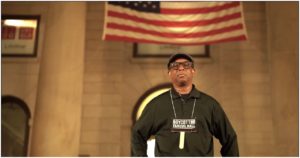As the U.S. military escalates its posture around Venezuela—with naval deployments in the Caribbean, B-52 overflights, lethal strikes on alleged drug boats, and confirmed CIA covert operations—advocates of regime change are reviving a dangerous analogy. Many have pointed to the United States’ 1989 invasion of Panama and toppling of dictator Manuel Noriega as proof that swift, surgical operations can get the job done.
In private conversations with several current and former U.S. officials, they have nodded toward this parallel. Venezuelan opposition leader María Corina Machado, who just last month was awarded the Nobel Peace Prize, has appealed to the United States for help fighting what she calls Venezuelan President Nicolás Maduro’s “war.” When asked about striking Venezuelan territory, U.S. President Donald Trump has refused to rule it out, saying, “Well, you’re going to find out.”
As the U.S. military escalates its posture around Venezuela—with naval deployments in the Caribbean, B-52 overflights, lethal strikes on alleged drug boats, and confirmed CIA covert operations—advocates of regime change are reviving a dangerous analogy. Many have pointed to the United States’ 1989 invasion of Panama and toppling of dictator Manuel Noriega as proof that swift, surgical operations can get the job done.
In private conversations with several current and former U.S. officials, they have nodded toward this parallel. Venezuelan opposition leader María Corina Machado, who just last month was awarded the Nobel Peace Prize, has appealed to the United States for help fighting what she calls Venezuelan President Nicolás Maduro’s “war.” When asked about striking Venezuelan territory, U.S. President Donald Trump has refused to rule it out, saying, “Well, you’re going to find out.”
The comparison between Panama in 1989 and Venezuela in 2025 is seductive. It is also fundamentally flawed. The two cases are different on nearly every structural and operational level. Mistaking the U.S. history in Panama for a template for U.S. action in Venezuela today could lead to a prolonged counterinsurgency.
The United States didn’t invade Panama in 1989. It attacked it from the inside. At the time, nearly 13,000 U.S. troops were permanently stationed in the country—a vestige of the U.S. role in overseeing the Panama Canal. When President George H.W. Bush gave the order to commence Operation Just Cause on Dec. 17, 1989, it required deploying 14,000 additional troops by air. But nearly half the invasion force was already on the ground, pre-positioned and intimately familiar with their targets.
Noriega had once been a U.S. intelligence asset, but he became increasingly hostile to U.S. interests throughout the 1980s. After Noriega nullified the May 1989 presidential elections won by opposition candidate Guillermo Endara, the Bush administration became convinced that only military force could restore Panama’s democracy.
For months before Bush’s orders to invade, U.S. forces conducted exercises through Operation Sand Flea—rehearsals disguised as force protection drills—that reduced the Panamanian Defense Forces’ (PDF) readiness to respond to U.S. troop movements. As the U.S. Army official history records, “exercises were run with such frequency that the enemy became desensitized to rapid movements of troops.”
By December 1989, U.S. intelligence knew Noriega’s command nodes as well as PDF unit dispositions and key officers. Operation Just Cause called for simultaneous strikes on two dozen PDF targets to sever their command-and-control capabilities before they could organize resistance. At around 1 a.m. on Dec. 20, it worked. Major combat operations concluded within five days, and Noriega surrendered on Jan. 3, 1990. By Jan. 12, the operation was over.
Venezuela is a completely different story. The United States has no forward presence, no in-country basing, no treaty rights, and no comparable intelligence infrastructure. Recent U.S. moves—helicopters near Trinidad and Tobago, warships in international waters, bomber patrols—may signal Washington’s resolve. But they don’t help project power into a country that lacks an existing U.S. foothold.
The original 1988 U.S. plan in Panama called for gradual military buildup over 22 days. After Noriega nullified the May 1989 elections, Bush replaced the head of the U.S. Southern Command. Gen. Maxwell Thurman compressed the timeline to three days and shifted to a surprise strategy. That plan worked because infrastructure to support it already existed. In Venezuela, it does not.
Even though the United States had every advantage in Operation Just Cause, it wasn’t a bloodless endeavor. The PDF fought harder than expected: On just the first day of the operation, an estimated 19 U.S. troops were killed and 99 wounded. Panamanian casualties included 300 to 500 civilian deaths.
Conflict in Venezuela would be much deadlier—in part due to geography. Panama is much smaller than Venezuela, at just 75,000 square kilometers. Venezuela is 12 times larger—and twice the size of Iraq, which consumed U.S. forces in counterinsurgency for nearly a decade. Moreover, where Panama is a narrow isthmus, Venezuela encompasses vast savannas, the Andes Mountains, the Amazon rainforest, and multiple major urban centers. This diverse terrain would complicate military operations at every level.
Manpower poses another problem: Unlike the PDF, Venezuelan forces and their allies can’t be decapitated in a weekend. In December 1989, the Panamanian military numbered 12,800 personnel—but only 4,000 were combat-ready. The PDF was a personalistic apparatus built around Noriega and his small circle of allies. Control was centralized in Panama City. When U.S. forces struck, they destroyed the PDF’s command spine in three hours. The PDF’s centralized structure meant the United States could neutralize it before it could mount guerrilla insurgency.
Venezuela’s security architecture, by contrast, is layered and resilient. The country’s military, the Bolivarian National Armed Forces, numbers between 130,000 and 160,000 active personnel. The Maduro regime also has cultivated parallel structures designed to prevent rapid military collapse. The Bolivarian Militia, comprised of reservists, claims more than 1.6 million members. And pro-government paramilitaries known as colectivos number approximately 100,000. They are decentralized and ideologically committed to Maduro’s party and operate with substantial autonomy in urban neighborhoods as rapid-response enforcers deployed against the opposition.
Then there are nonstate actors. Colombian guerrilla groups—dissidents of the Revolutionary Armed Forces of Colombia and the National Liberation Army—maintain a presence in Venezuela’s border regions, controlling drug smuggling as well as illegal mining of gold and other minerals.
The differences don’t stop on the ground. In 1989, Panama had no meaningful air defenses, allowing U.S. aircraft to operate freely. But Venezuela could briefly contest the skies. The Venezuelan Army operates S-300VM Antey-2500 long-range surface-to-air systems capable of engaging aircraft at ranges up to 200 kilometers. The military also fields S-125 Pechora medium-range systems and Igla-S man-portable air defense systems. After years of poor maintenance, these systems’ operational readiness is unclear.
But even degraded defenses impose risk: Any serious U.S. air campaign against Venezuela would require it to suppress enemy air defenses via direct strikes that could escalate to open warfare.
On Dec. 19, 1989, hours before Operation Just Cause began, the U.S. deputy chief of mission stationed in Panama invited Endara, the winner of the May elections, and his two running mates to a secret meeting. Thurman briefed them on the status of the operation and offered them their elected offices. Just before midnight, a Panamanian judge administered their oaths.
Thus, when U.S. forces struck at 1 a.m., Panama had a functioning alternative government. Endara’s administration provided political legitimacy to the invasion and began dissolving the PDF. This immediate succession was critical: Operation Just Cause led to regime change, not occupation.
Venezuela has no equivalent government in waiting. Machado has been forced into hiding. Opposition presidential candidate Edmundo González, who won last year’s election according to independent counts, fled the country after the Maduro regime issued a warrant for his arrest. The political opposition remains divided about how to confront Maduro: Some favor negotiation, others street mobilization, and yet others military defection.
A U.S. occupation or appointed transitional council would transform Venezuelan liberation into imperialism—and provide Maduro’s remnants with a nationalist cause for resistance.
In 1989, the United States faced minimal international blowback to its invasion of Panama: The Cold War was ending, the Soviet Union was collapsing, and Latin American governments were not prepared to challenge Washington militarily or economically. The Organization of American States condemned the invasion, but the United States faced only rhetorical consequences. Panama itself, traumatized by civilian casualties and destruction, ultimately accepted Endara’s government.
In 2025, the geopolitical chessboard is crowded. China has deepened its economic presence across Latin America through infrastructure investments, port operations, and financial partnerships. While Trump has inflamed U.S. concerns about Chinese influence at the Panama Canal, the broader pattern of Chinese engagement complicates unilateral U.S. military action in the region. Russia and Iran also maintain security relationships with Venezuela. Latin American governments, even those hostile to Maduro, remain deeply skeptical of U.S. military intervention.
None of this is to say that the U.S. military lacks the capability to topple Maduro. In 1991, Iraq fielded what was considered the fifth-largest army in the world, yet the U.S. ground campaign that liberated Kuwait lasted just 100 hours. The argument here is structural, not doctrinal. Military capabilities and operational conditions are distinct variables. Venezuela is not Panama, and the conditions that enabled Operation Just Cause’s rapid success do not exist today.
The Panama analogy persists because it’s emotionally satisfying for U.S. hawks: swift action, minimal cost, moral clarity. But Washington cannot invade its way to desired outcomes in Caracas. A U.S. occupation of Venezuela would last years, with the likelihood of a stable, democratic country emerging close to zero. Pretending otherwise isn’t strategy—it’s nostalgia.






